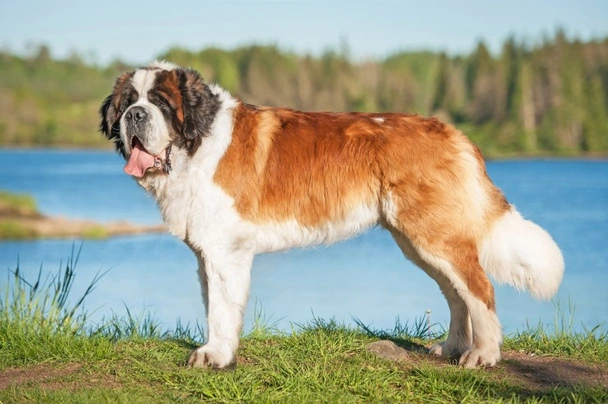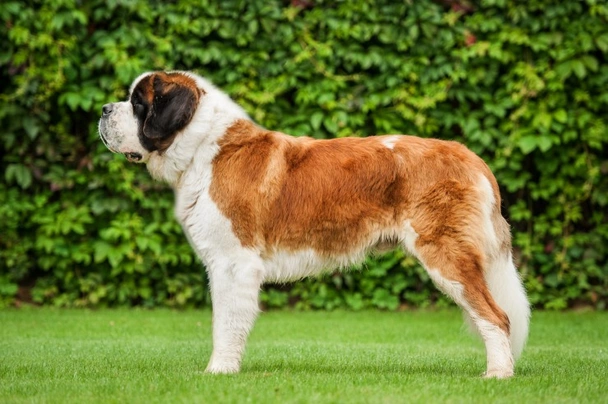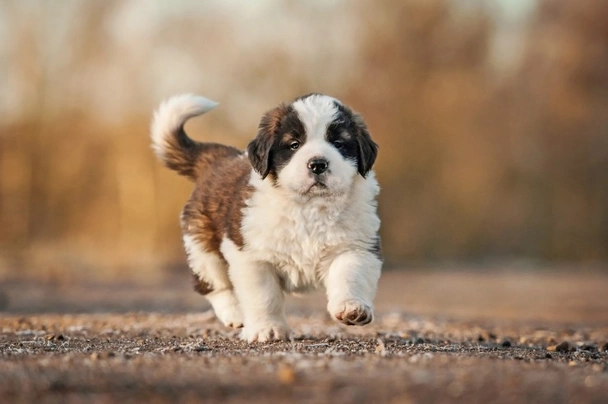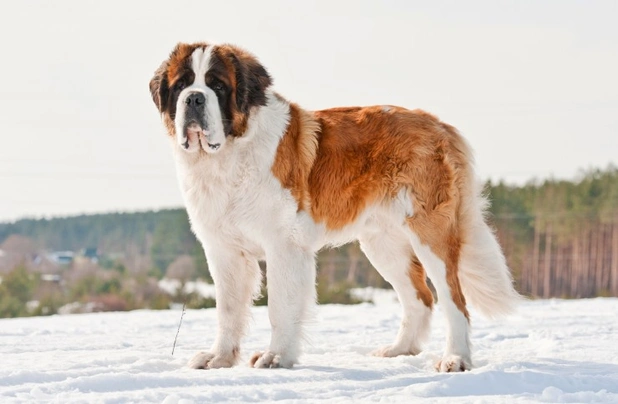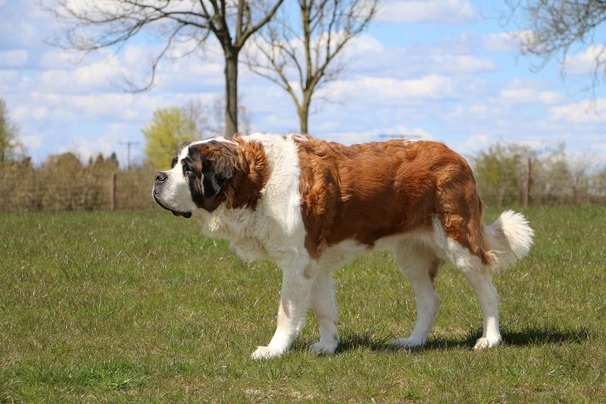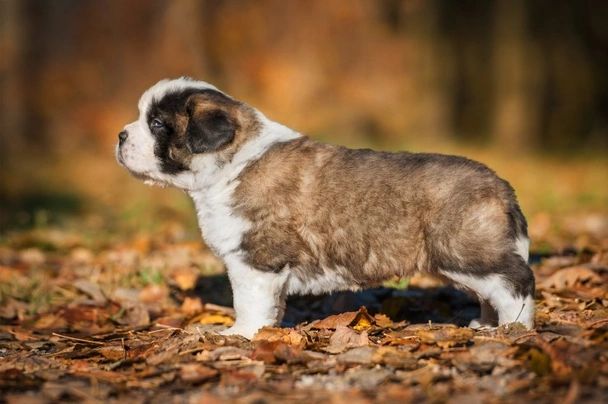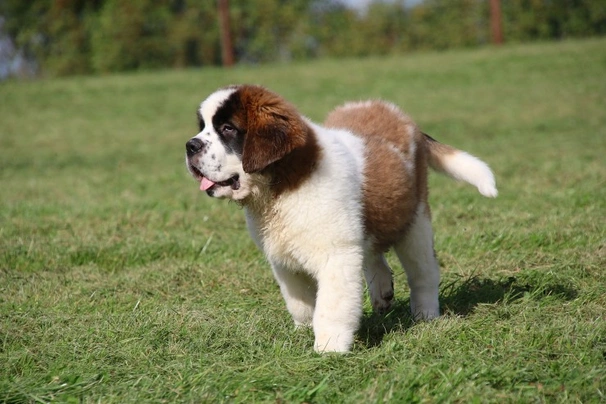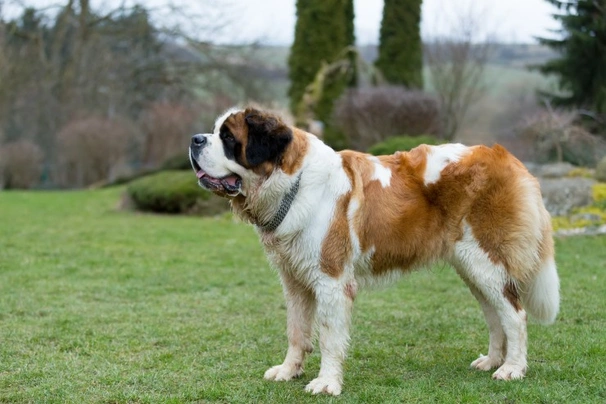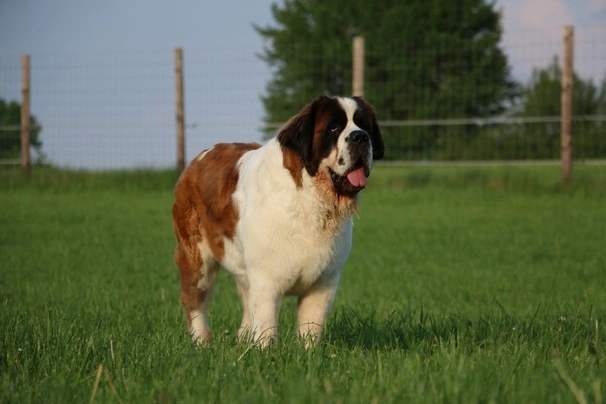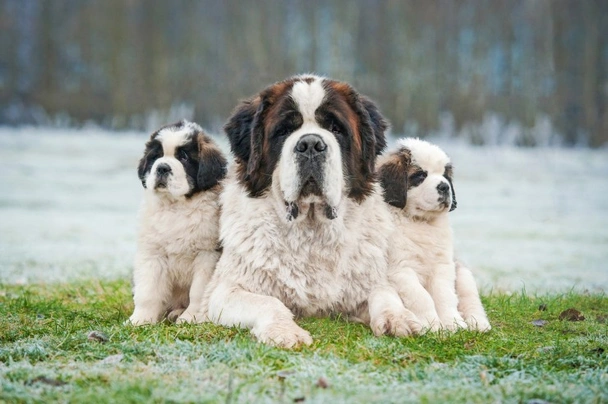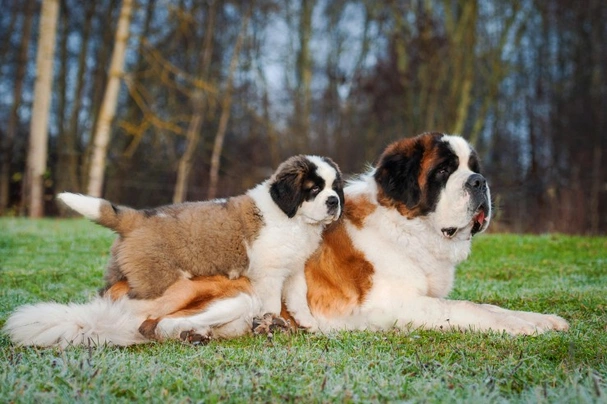Saint Bernard
Pros
Cons
Introduction of the Saint Bernard
The Saint Bernard is one of the largest breeds on the planet and they are renowned for being Switzerland's famous mountain rescue dogs and the breed is renowned the world over for being a "gentle giant". These charming larger than life dogs have found their way into the hearts and homes of many people the world over thanks to their kind patient and affectionate natures and more especially when they are around children of all ages.
Although extremely large Saint Bernards don't need as much room to express themselves as they should that most people think and providing they are given enough daily exercise and mental stimulation they are just as happy living in a smaller home as they are living in a big house in the country. With this said all dogs including Saint Bernards love to be able to roam around in a secure back garden whenever they can. Saint Bernards shed copious amounts of hair all year long which means they are not the best choice for anyone who is very house proud but a great choice for people who are looking for a large loving and gentle dog that's especially good around children.
History of the Saint Bernard
The St. Bernard is named after the Hospice of the Great Saint Bernard Pass which is an Alpine route that connects Switzerland with neighbouring Italy and there are records and paintings of these large dogs that date back to 1707 and even earlier although these dogs looked quite different to the Saint Bernards we see today. It was the monks who founded the hospice in AD 980 and they used their dogs to rescue travellers lost in the pass so they could provide them with refuge in the hospice. These dogs excelled at finding lost people because they can track their way in atrocious weather conditions that people could not cope with. These large dogs would find lost travellers and bringing them back to the hospice when a blizzard was blowing up a storm.
The breed was originally called the Alpine Mastiff and dogs were often depicted in paintings by well-known artists. One such artist being Edwin Landseer who painted the dogs with brandy barrels around their necks which became a world-famous symbol of the Saint Bernard although the dogs never actually carried any casks at all.
During the early 1800's they were also often called "Barry" dogs after a famous St. Bernard called Barry. Legend has it that he rescued 40 lost travellers in the pass. The breed almost vanished altogether during the 1830's because the monks of the day interbred their dogs far too much which along with several very severe winters and dogs developing diseases resulted in their numbers being decimated. As a result the monks began crossing their dogs with Newfoundlands the Great Pyrenees dog and it is thought they introduced Great Danes into the mix too and this led to the creation of the dogs we see today although at the time they were not as heavy and taller in the leg. The St. Bernard remains the monastery's mascot to this day.
The monks had originally only used Newfoundlands imported to the country during the 1850's in an attempt to rescue the breed but their endeavours were not successful because dogs had heavier coats which were at risk of becoming frozen and clogged up with snow which would weigh a dog down. As such they introduced the other breeds into the mix to create a lighter coated dog.
It was not until 1870 that St. Bernard's first appeared in America when the Rev. J C Macdona bought the breed to the public's attention and they were an immediate hit. Seven years later in 1877 the first dogs were exhibited at the Westminster Kennel Club show after which time the breed's popularity gained momentum in the States.
The Swiss Saint Bernard Club was founded in Basel on the 15th March 1884 and the breed standard was approved in 1888. Since then the breed has been regarded as Switzerland's national dog. Today the Saint Bernard is still a popular breed here in the UK and elsewhere in the world thanks to their wonderfully kind loyal natures and their proud impressive looks with them being the National dog in Switzerland.
Interesting facts about the breed
- Is the Saint Bernard a vulnerable breed? No they are among the most popular in the UK and elsewhere in the world thanks to their gentle and kind natures
- The Saint Bernard is Switzerland's national dog
- The breed was once called the "Barry Dog" after a famous Saint Bernard called Barry
- They were also known as Noble Steeds
- The Saint Bernard has an extremely weather resistant coat which helps them cope with extreme cold but it means they can overheat very quickly in warmer weather when in cars and warmer houses
- Saint Bernards are not only strong and powerful dogs but they are highly intelligent too
Appearance of the Saint Bernard
Height at the withers: Males 70 - 90 cm Females 65 - 80 cm
Average weight: Males 64 - 120 kg Females 64 - 120 kg
St. Bernards are large powerful and muscular dogs with imposing heads and a kind intelligent look in their eyes. They are one of the most recognised dogs in the world thanks to their search and rescue history. They boast very large heads with short muzzles and a nice square nose on the end of it. They have well defined stops and the top of their head is nicely domed adding to the breed's gentle intelligent look. They also have quite a noticeable brow over medium sized dark eyes which always have a gentle kind and intelligent look about them.
Their ears are moderately large and lie close to a dog's cheeks being lightly feathered. The St. Bernard has a strong jaw with a perfect scissor bite where their upper teeth neatly overlap their lower ones. Their necks are thick and long being well muscled and slightly arched with St. Bernards having well developed dewlaps. Their shoulders are broad and slope well up at a dog's withers. Their front legs are straight well boned long and powerful.
They have powerful bodies with a broad level back and a well-rounded ribcage. Their loins are wide and well-muscled with their croup being broad and gently sloping to the root of the tail. Chests are deep and wide with St. Bernards boasting strong powerful and well-muscled first and second thighs on their back legs. Their feet are large and compact with dogs having well arched toes. Tails are set high and are long with dogs carry down when at rest but higher when they are alert or on the move.
When it comes to their coat the St. Bernard can either have a rough or a smooth coat. Rough coated dogs have a dense coat that lies close to the body with the hair being a lot fuller around their necks thighs and their tails are well feathered. In smooth coated dogs the hair lies close and there is only a slight amount of feathering on their thighs and tails. The accepted breed colours for Kennel Club registration are as follows:
- Brown & White
- Brown & White & Dark Shadings
- Mahogany & White
- Mahogany Black & White
- Mahogany Brindle
- Mahogany White & Dark Shadings
- Mahogany White Orange Shadings
- Orange & White
- Orange & White & Dark Shadings
- Orange Black & White
- Red & White
- Red & White & Dark Markings
- Red Brindle
- Tricolour
Gait/movement
When a Saint Bernard moves they do so in a smooth unhurried way with a tremendous amount of power coming from their hindquarters while their backs always remain firm and level. Their back feet track their front ones which helps dogs cover harsher and more challenging terrains.
Faults
The Kennel Club frowns on any exaggeration or departure from the breed standard and would judge faults on how much they affect a dog' overall health and wellbeing as well as their ability to perform.
Male dogs should have both testicles fully descended into their scrotums and it is worth noting that dogs can be a little shorter or taller as well as slightly lighter or heavier than stated in the Kennel Club breed standard which is given as a guideline only.
Temperament of the Saint Bernard
The St. Bernard is renowned for being a laid-back character and one that forms an extremely strong bond with their family. They are incredibly loyal and will do their utmost to please an owner which means that in the right hands and in the right environment these large dogs are easy to train and will do their best to get things right. In short a St. Bernard is often a lot easier to train and handle than many smaller breeds.
St. Bernards are social dogs by nature and generally get on with everyone they meet. They are a great choice as a family pet although they may just knock a toddler or younger child over albeit it by accident due to their sheer size. Rarely would one of the large gentle giants show any sort of aggressive behaviour. Because they form such strong bonds with their owners St. Bernards don't like it when they are left on their own and often develop separation anxiety if they are. As such they are a good choice for families where at least one person stays at home when everyone else is out of the house.
They are not the best choice for first time owners because they do that much better with people who are familiar with their needs and this type of very large dog which includes the cost of keeping them which is a lot more than for your average sized dog. Although they don't need as much space as one would first think Saint Bernards do enjoy being able to roam around in a secure back garden whenever they can bearing in mind that during the hotter months of the year care should be taken as to when a dog is exercised or let outside because they do not tolerate heat very well thanks to their thick dense coats.
St. Bernards have a very distinct odour about them which is rather musky that some people might find hard to live with. They are also known to slobber and dribble quite a lot which means they are not the best choice for anyone who is house proud. The other thing to bear in mind is that these large dogs can suffer during the hotter summer months so care must be taken as to when they are exercised to avoid them overheating which can easily happen when the weather is warmer. They are also extremely prone to overheating in cars and warmer rooms for the same reason.
Are they a good choice for first time owners?
The Saint Bernard as previously mentioned is not the best choice for first time dog owners because of their large size and the fact they need to be handled and trained correctly right from the word go so they don't grow up to be unruly very large dogs. With this said in the right hands and environment they are the perfect family pet and companion.
What about prey drive?
Saint Bernards are very social by nature and as such they do not have a very high prey drive. However this is not to say that a dog would not give chase to a smaller animal when the mood takes them and this includes squirrels and the cat from next door albeit rather slowly.
What about playfulness?
Saint Bernards have a very playful side to their natures and love to entertain and be entertained albeit in their own time because these large dogs like to think about things before reacting. It is also important not to overdo things because Saint Bernards can overheat all too easily thanks to their thick dense coats.
What about adaptability?
Saint Bernards do not adapt well to apartment living being such large dogs they need enough space to express themselves as they should. As such they are better suited to people who have secure back gardens a dog can roam around in as often as possible bearing in mind that dogs still need a lot of daily exercise and mental stimulation to be truly happy too.
What about separation anxiety?
Saint Bernards form strong ties with their families and dogs are never very happy when they find themselves left on their own for longer periods of time. They are better suited to people who either work from home or in households where one person stays at home when everyone else is out so they are never alone for any length of time which could see a dog suffering from separation anxiety. This can lead to them being destructive around the home which is a dog's way of relieving any stress they are feeling and a way to keep themselves entertained.
What about excessive barking?
Saint Bernards are not known to be "barkers" being quieter dogs by nature but a dog would be quick to let their owner know when they are strangers about or when something they don't like is going on around them. As previously mentioned their sheer size is usually enough to put wrongdoers off.
Do Saint Bernards like water?
Most Saint Bernards like swimming and will take to the water whenever they can more especially when the weather is hot. However if anyone who owns a dog that does not like water should never force them to go in because it would just end up scaring them. With this said care should always be taken when walking a Saint Bernard off the lead anywhere near more dangerous watercourses just in case a dog decides to leap in and then needs rescuing bearing in mind that their heavy coats could weigh them down.
Are Saint Bernards good watchdogs?
Saint Bernards are not natural watchdogs although as previously mentioned this is not to say a dog would not be quick off the mark to let an owner know when there are strangers about although rarely would a dog show any sort of aggression.
Intelligence / Trainability of the Saint Bernard
The St. Bernard is an intelligent dog but they are known to "slow thinkers". As such their training can never be rushed but it must be started early before dogs get too big. It's essential for puppies to be well socialised from a young enough age and it should include introducing them to new situations noises people other animals and dogs once they have been fully vaccinated so they grow up to be confident outgoing mature dogs.
As previously mentioned their training must start early so that puppies can be taught the "basics" and special attention has to be paid to teaching these large dogs not to pull on their leads which if left too late could well prove to walk a powerful fully grown dog. Saint Bernards are never happier than when rules and boundaries are set for them so they understand what their owners expect of them.
Puppies need to be taught the ground rules from an early age so they understand the limits and boundaries an owner sets for them. Saint Bernards should be taught the first following commands right from the word go:
- Come
- Sit
- Stay
- Quiet
- Leave it
- Down
- Bed
Children and other
The Saint Bernard revels in being in a family environment. They are placid fun-loving and completely trustworthy which is why they are such wonderful dogs to have as family pets. However thanks to their sheer size care must be taken when a Saint Bernard is around toddlers and young children just in case they knock them over by accident which is the biggest danger with such large dogs. As such any interaction between younger children and such a large dog should be supervised by an adult to make sure nobody gets frightened or hurt.
Saint Bernards generally get on well with other pets in a household especially if they have grown up together. However care should be taken when they meet any small animals they don't already know just in case. These large dogs are social by nature and as such they get on with other dogs and would rarely be the ones to start a fight.
Health of the Saint Bernard
The average life expectancy of a St. Bernard is between 8 and 10 years when properly cared for and fed an appropriate good quality diet to suit their ages.
Like so many other breeds the St. Bernard is known to suffer from a few hereditary health issues which are worth knowing about if you are planning share your home with one of these large and impressive dogs. The conditions that seem to affect the breed the most include the following:
- Entropion - an eye disorder that sees eyelids rolling inwards causing irritation and damage to a dog's cornea and which left untreated could cause blindness
- Hip dysplasia - a high percentage (40%) of Saint Bernards suffer from the condition and stud dogs must be tested
- Skin infections - thanks to their thick dense coats Saint Bernards are predisposed to hot spots and other skin issues
- Diabetes mellitus - Saint Bernards have higher levels of growth hormones which puts them at greater risk of developing the condition
- Bone cancer/osteosarcoma
- Epilepsy - a condition that could be hereditary and therefore dogs diagnosed with the condition should never be used for breeding purposes
- Bloat/gastric dilatation volvulus (GDV)
- Heart disorders and more especially cardiomyopathy
- Osteochondritis
- Panosteitis
- Elbow dysplasia
- Genu valgum
- Abnormal calcification
- Pituitary abnormalities
What about vaccinations?
Saint Bernard puppies would have been given their initial vaccinations before being sold but it is up to their new owners to make sure they have their follow-up shots in a timely manner with the vaccination schedule for puppies being as follows:
- 10 -12 weeks old bearing in mind that a puppy would not have full protection straight away but would be fully protected 2 weeks after they have had their second vaccination
There has been a lot of discussion about the need for dogs to have boosters. As such it's best to talk to a vet before making a final decision on whether a dog should continue to have annual vaccinations which are known as boosters.
What about spaying and neutering?
A lot of vets these days recommend waiting until dogs are slightly older before spaying and neutering them which means they are more mature before undergoing the procedures. As such they advise neutering males and spaying females when they are between the ages of 6 to 9 months old. Other vets recommend spaying and neutering dogs when they are 6 months old but never any earlier unless for medical reasons.
What about obesity problems?
Some Saint Bernards gain weight after they have been spayed or neutered and it's important to keep an eye on a dog's waistline just in case they do. If a dog starts to put on weight it's important to adjust their daily calorie intake and to up the amount of exercise they are given. Older Saint Bernards too are more prone to gaining weight and again it's essential they be fed and exercised accordingly because obesity can shorten a dog's life by several years. The reason being that it puts a lot of extra strain on a dog's internal organs including the heart which has to work that much harder to pump blood around a dog’s body.
What about allergies?
Saint Bernards are prone to suffering from allergies and it's important for a dog to see a vet sooner rather than later if one flares up bearing in mind that skin complaints are a real problem in the breed which includes them suffering from "hot spots". Allergies can be notoriously hard to clear up and finding the triggers can be challenging. With this said a vet would be able to make a dog with an allergy more comfortable while they try to find out the triggers which could include the following:
- Certain foods and more especially commercially produced food which contains cereals
- Airborne pollens
- Dust mites
- Environment
- Flea and tick bites
- Chemicals found in everyday household cleaning products
Participating in health schemes
All responsible Saint Bernard breeders would ensure that their stud dogs are tested for known hereditary and congenital health issues known to affect the breed by using the following scheme:
The Kennel Club also strongly advises that all breeders should adhere to the following advice for the welfare of female Saint Bernards:
- Bitches must not to produce a litter when they are under 2 years old
What about breed specific breeding restrictions?
Apart from the standard breeding restrictions for all Kennel Club registered breeds there are no other breed specific breeding restrictions for Saint Bernards.
What about Assured Breeder Requirements?
It is mandatory for all KC Assured Breeders to use the following test on stud dogs and the Kennel Club strongly advises that all other breeders follow suit:
- BVA/KC Hip Dysplasia Scheme
- The Kennel Club also strongly advises that all breeders adhere to the following advice for the welfare of the breed:
- Bitches must not to produce a litter when they are under 2 years old
Caring for the Saint Bernard
As with any other breed Saint Bernards need to be groomed on a regular basis to make sure their coats and skin are kept in top condition bearing in mind that because they have thick dense coats they are extremely prone to suffering from skin issues which includes hot spots. They also need to be given regular daily exercise to ensure they remain fit and healthy. On top of this dogs need to be fed good quality food that meets all their nutritional needs throughout their lives.
Caring for a Saint Bernard puppy
Saint Bernard puppies are boisterous and full of life which means it's essential for homes and gardens to be puppy-proofed well in advance of their arrival. A responsible breeder would have well socialised their puppies which always leads to more outgoing confident and friendly dogs right from the word go. With this said any puppy is going to feel vulnerable when they leave their mother and littermates which must be taken into account. The longer a puppy can remain with their mother the better although it should never be for too long either.
It's best to arrange to pick puppy up when people in the home are going to be around for the first week or so which is the time needed for a puppy to settle in. Puppy-proofing the home and garden means putting away any tools and other implements that a boisterous puppy might injure themselves on. Electric wires and cables must be put out of their reach because puppies love chewing on things. Toxic plants should be removed from flowerbeds and the home too.
Puppies need to sleep a lot to grow and develop as they should which means setting up a quiet area that's not too out of the way means they can retreat to it when they want to nap and it's important not to disturb them when they are sleeping. It's also a good idea to keep "playtime" nice and calm inside the house and to have a more active "playtime" outside in the garden which means puppies quickly learn to be less boisterous when they are inside.
The documentation a breeder provides for a puppy must have all the details of their worming date and the product used as well as the information relating to their microchip. It is essential for puppies to be wormed again keeping to a schedule which is as follows:
- Puppies should be wormed at 6 months old
- They need to be wormed again when they are 8 months old
- Puppies should be wormed when they are 10 months old
- They need to be wormed when they are 12 months old
Things you'll need for your puppy
There are certain items that new owners need to already have in the home prior to bringing a new puppy home. It's often a good idea to restrict how much space a puppy plays in more especially when you can't keep an eye on what they get up to bearing in mind that puppies are often quite boisterous which means investing in puppy gates or a large enough playpen that allows a Saint Bernard puppy the room to express themselves while keeping them safe too. The items needed are therefore as follows:
- Good quality puppy or baby gates to fit on doors
- A good well-made playpen that's large enough for a puppy to play in so they can really express themselves as puppies like to do
- Lots of well-made toys which must include good quality chews suitable for puppies to gnaw on bearing in mind that a puppy will start teething anything from when they are 3 to 8 months old
- Good quality feed and water bowls which ideally should be ceramic rather than plastic or metal
- A grooming glove
- A slicker brush or soft bristle brush
- Dog specific toothpaste and a toothbrush
- Scissors with rounded ends
- Nail clippers
- Puppy shampoo and conditioner which must be specifically formulated for use on dogs
- A well-made dog collar or harness
- A couple of strong dog leads
- A well-made dog bed that's not too small or too big
- A well-made dog crate for use in the car and in the home that's large enough for a puppy to move around in
- Baby blankets to put in your puppy's crate and in their beds for when they want to nap or go to sleep at night
Keeping the noise down
All puppies are sensitive to noise including Saint Bernard puppies. It's important to keep the noise levels down when a new puppy arrives in the home. TVs and music should not be played too loud which could end up stressing a small puppy out.
Keeping vet appointments
As previously mentioned Saint Bernard puppies would have been given their first vaccinations by the breeders but they must have their follow up shots which is up to their new owners to organise. The vaccination schedule for puppies is as follows:
- 10 -12 weeks old bearing in mind that a puppy would not have full protection straight away but would only be fully protected 2 weeks after they have had their second vaccination
When it comes to boosters it's best to discuss these with a vet because there is a lot of debate about whether a dog really needs them after a certain time. However if a dog ever needed to go into kennels their vaccinations would need to be
What about older Saint Bernard when they reach their senior years?
Older Saint Bernards need lots of special care because as they reach their golden years they are more at risk of developing certain health concerns. Physically a Saint Bernard will start to have a greying muzzle but there will be other noticeable changes too which includes the following:
- Coats become coarser and often thinner
- A loss of muscle tone
- Saint Bernards can either become overweight or underweight
- They have reduced strength and stamina
- Older dogs have difficulty regulating their body temperature
- They often develop arthritis
- Immune systems do not work as efficiently as they once did which means dogs are more susceptible to infections
- Older dogs change mentally too which means their response time tends to be slower as such they develop the following:
- They respond less to external stimuli due to impaired vision or hearing
- They tend to be a little pickier about their food
- They have a lower pain threshold
- Become intolerant of any change
- Often an older dog can feel disorientated
Living with a Saint Bernard in their golden years means taking on a few more responsibilities but these are easily managed and should include taking a look at their diet the amount of exercise they are given how often their dog beds need changing and keeping an eye on the condition of their teeth.
Older Saint Bernards need to be fed a good quality diet that meets their needs at this stage of their lives all the while keeping a close eye on a dog's weight. A rough feeding guide for older Saint Bernards is as follows bearing in mind they should be fed highly digestible food that does not contain any additives:
- Protein content should be anything from 14 – 21%
- Fat content should be less than 10%
- Fibre content should be less than 4%
- Calcium content should be 0.5 – 0.8%
- Phosphorous content should be 0.4 – 0.7%
- Sodium content should be 0.2 – 0.4%
Older Saint Bernards don't need to be given the same amount of daily exercise as a younger dog but they still need the right amount of physical activity to maintain muscle tone and to prevent a dog from putting on too much weight. All dogs need access to fresh clean water and this is especially true of older dogs when they reach their golden years because they are more at risk of developing kidney disorders.
Grooming of the Saint Bernard
The St. Bernard boasts a lush coat and they are known to be prolific shedders as such they need to be brushed at least a few times a week and ideally this should be daily to remove any loose and dead hair from their coats. A lot of people take their dogs to be professionally groomed at least 3 to 4 times a year which makes it that much easier for them to keep their dog's coat in good condition in between visits to the grooming parlour. They shed all year round although it tends to be more during the Spring and then again in the Autumn when more frequent grooming is necessary to stay on top of things.
Dogs with droopy eyes need to have the area around their eyes checked and gently wiped with a soft damp cloth to keep things clean which reduces the chance of any painful sores developing. It's also important to check a dog's ears on a regular basis and to clean them when necessary. If too much wax is allowed to build up in a dog's ears it can lead to a painful infection which can be hard to clear up. In short prevention is often easier than cure when it comes to ear infections.
Exercise of the Saint Bernard
St. Bernards need to be given the right amount of daily exercise to keep them fit happy and healthy. This means a good 60 - 80 minutes a day which should include a lot of "off the lead" time so that dogs can really express themselves. A shorter walk in the morning would be fine but a longer more interesting one in the afternoon is a must. These dogs also like to be able to roam around a back garden as often as possible so they can really let off steam. However the fencing has to be extremely secure to keep these large dogs in because if they find a weakness in the fence they will soon escape out and get into all sorts of trouble.
With this said St. Bernard puppies should not be over exercised because their joints and bones are still growing. This includes not letting a dog jump up and down from furniture or going up or down the stairs. Too much pressure placed on their joints and spines at an early age could result in a dog developing problems later in their lives.
Feeding of the Saint Bernard
If you get a St. Bernard puppy from a breeder they would give you a feeding schedule and it's important to stick to the same routine feeding the same puppy food to avoid any tummy upsets. You can change a puppy's diet but this needs to be done very gradually always making sure they don't develop any digestive upsets and if they do it's best to put them back on their original diet and to discuss things with the vet before attempting to change it again. It's important to get a St. Bernard's diet when they are puppies because it stands them in good stead later on in their lives and the reverse may be true if they are fed incorrectly at a crucial stage of their lives when they are still growing and maturing.
Older dogs are not known to be fussy or finicky eaters but this does not mean you can feed them a lower quality diet. It's best to feed a mature dog twice a day once in the morning and then again in the evening making sure it's good quality food that meets all their nutritional requirements. It's also important that dogs be given the right amount of exercise so they burn off any excess calories or they might gain too much weight which can lead to all sorts of health issues. Obesity can shorten a dog's life by several years so it's important to keep an eye on their waistline from the word go.
Because the St. Bernard is prone to suffer from bloat it is really important that they be fed twice a day instead of giving them just one larger meal a day. It's also a good idea to invest in a stand to place their feed bowl which makes it easier for these large dogs to eat comfortably without having to stretch their necks down low to reach their food. You should never exercise a dog just before or just after they have eaten either because this puts them more at risk of suffering from bloat.
Feeding guide for a Saint Bernard puppy
Puppies need to be fed a highly nutritious good quality diet for them to develop and grow as they should. As a rough guide a Saint Bernard puppy can be fed the following amounts every day making sure their meals are evenly spread out throughout the day and it's best to feed them 3 or 4 times a day:
- 2 months old - 394g to 547g depending on puppy's build
- 3 months old - 504g to 730g depending on puppy's build
- 4 months old - 556g to 809g depending on puppy's build
- 5 months old - 658g to 972g depending on puppy's build
- 6 months old - 607g to 1104g depending on puppy's build
- 8 months old - 755g to 1129g depending on puppy's build
- 9 months old - 701g to 1113g depending on puppy's build
- 10 months old - 658g to 1248g depending on puppy's build
- 11 months old - 613g to 1101g depending on puppy's build
- 12 months old - 574g to 1041g depending on puppy's build
- 13 months old - 538g to 1084g depending on puppy's build
- 14 months old - 535g to 1031g depending on puppy's build
Once a puppy is 15 months old they can be fed adult dog food.
Feeding guide for an adult Saint Bernard
Once fully mature an adult Saint Bernard must be fed a good quality diet to ensure their continued good health. As a rough guide an adult Saint Bernard can be fed the following amounts every day:
- Dogs weighing 64kg can be fed 519g to 683g depending on activity
- Dogs weighing 75kg can be fed 578g to 761g depending on activity
- Dogs weighing 85kg can be fed 635g to 836g depending on activity
- Dogs weighing 95kg can be fed 692g to 911g depending on activity
- Dogs weighing 100kg can be fed 717g to 944g depending on activity
- Dogs weighing 110kg can be fed 742g to 977g depending on activity
- Dogs weighing 120kg can be fed 767g to 1010g depending on activity
Saint Bernard price
If you are looking to buy a Saint Bernard you would need to pay anything from £500 to over £1200 for a well-bred pedigree puppy. The cost of insuring a male 3-year-old Saint Bernard in northern England would be £66.42 a month for basic cover but for a lifetime policy this would set you back £117.19 a month (quote as of September 2017). When insurance companies calculate a pet's premium they factor in several things which includes where you live in the UK a dog's age and whether they have been neutered or spayed among other things.
When it comes to food costs you need to buy the best quality food whether wet or dry to feed your dog making sure it suits the different stages of their lives. This would set you back between £80 - £100 a month. On top of this you would need to factor in veterinary costs if you want to share your home with a Saint Bernard and this includes their initial vaccinations their annual boosters the cost of neutering or spaying a dog when the time is right and their yearly health checks all of which quickly adds up to over £2000 a year.
As a rough guide the average cost to keep and care for a Saint Bernard would be between £150 to £220 a month depending on the level of insurance cover you opt to buy for your dog but this does not include the initial cost of buying a well-bred healthy Kennel Club registered pedigree puppy.
Buying advice
When visiting and buying any puppy or dog there are many important things to consider and questions to ask of the breeder/seller. You can read our generic puppy/dog advice here which includes making sure you see the puppy with its mother and to verify that the dog has been wormed and microchipped.
Saint Bernards are an extremely popular breed both in the UK and elsewhere in the world which means that well-bred puppies command a lot of money. As such with Saint Bernards there is specific advice questions and protocols to follow when buying a puppy which are as follows:
- Beware of online scams and how to avoid them. You may see online and other adverts by scammers showing images of beautiful Saint Bernard puppies for sale at very low prices. However the sellers ask buyers for money up front before agreeing to deliver a puppy to a new home. Potential buyers should never buy a puppy unseen and should never pay a deposit or any other money online to a seller. You should always visit the pet at the sellers home to confirm they are genuine and make a note of their address.
- As previously touched upon Saint Bernards are among the most popular breeds in the UK. As such there are many amateur breeders/people who breed from Saint Bernard bitch far too often so they can make a quick profit without caring for the welfare of the puppies their dam or the breed in general. Under Kennel Club rules a dam can only produce 4 litters and she must be between a certain age to do so. Anyone wishing to buy a Saint Bernard puppy should think very carefully about who they purchase their puppy from and should always ask to see the relevant paperwork pertaining to a puppy's lineage their vaccinations and their microchipping
- Prospective owners should be made aware that any exaggerated features in a Saint Bernard puppy are a direct result of bad breeding practices
